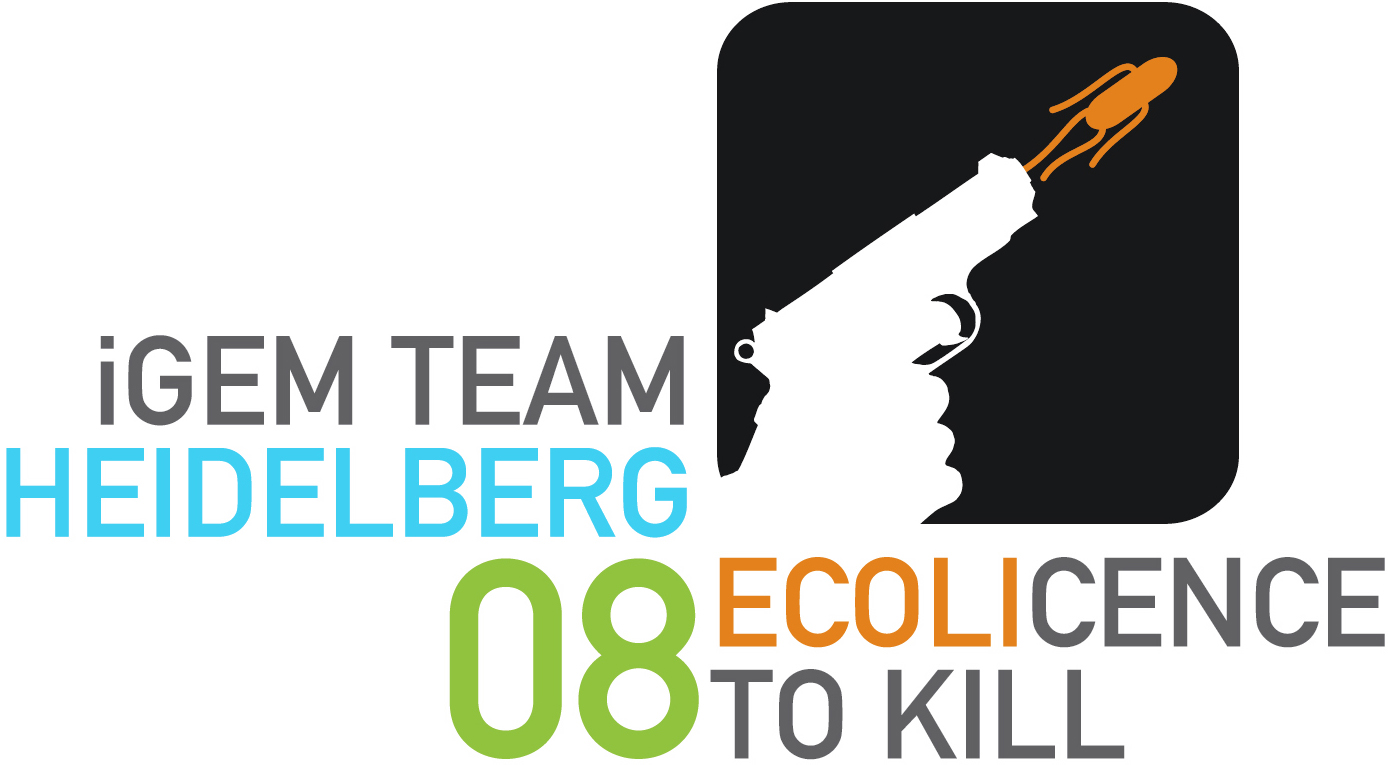Team:Heidelberg
From 2008.igem.org
-
Home
Available Languages
Project Draft
Ecolicence to kill: Engineering E. coli for targeting pathogenic microorganisms
Pathogenic microorganisms represent a major challenge to both medicine and industry. Microbial communities known as biofilms prove to be particularly resistant to conventional therapies and demonstrate the need for alternative methods to fight bacterial growth. The formation of biofilms, as well as other processes such as virulence, antibiotic production, and sporulation, are regulated by communication circuits that depend on small signalling molecules called autoinducers. Our aim is to exploit this communication mechanism by engineering synthetic bacteria that are able to target potentially harmful autoinducer-secreting species and kill them. Working with E. coli as a model system, we plan to engineer separate “killer” and “prey” cells, and divide our project into two complementary modules. The “sensing module” comprises the modification of E. coli’s chemotaxis system to make killer cells move towards prey cells.This requires the engineering of a “sensing module” which propagates a prey-specific stimulus to the downstream signalling cascades, prompting the cells to swim towards the gradient of such a stimulus. The directed swimming stops only in the region where the stimulus is maximal, i.e. in the vicinity of the prey. The “killing module” ensures that once in the vicinity of the prey, a bacteriocidal mechanism is activated. Computer models will show how both modules behave in concert and probe the efficiency of the system in defined spatial environments. Future directions, which are beyond the scope of this project, include the modification of the sensory and killing modules, adjusting the range of targets to real pathogens, but also other organisms, specific cell types or even cancer cells.
Projekt Beschreibung
 German back
German back
Ecolicence to kill: Engineering E. coli for targeting pathogenic microorganisms
Im Heidelberger iGEM-Team arbeiten 15 Studenten der Universität Heidelberg und eine Studentin der TU Darmstadt aus den Bereichen Molekulare Biotechnologie, Biologie und Mathematik zusammen. Sie werden unterstützt von Betreuern aus der Arbeitsgruppe von Victor Sourjik im ZMBH der Universität Heidelberg und aus der Abteilung von Roland Eils (Universität Heidelberg und Deutsches Krebsforschungszentrum). Die Arbeiten selbst werden am Bioquant, dem erst 2007 ins Leben gerufenen neuen Zentrum für quantitative Analy-se molekularer und zellulärer Biologischer Systeme, durchgeführt. Das Heidelberger Team plant eine biologische Maschine, die Krankheitserreger oder auch Tumorzellen er-kennen und spezifisch abtöten kann. Als Modell dafür entwickeln die Studenten ein künstliches System aus zwei Stämmen des Darmbakteriums E. coli: einem „Beutestamm“, der die Krankheitserreger repräsentiert, und einem „Killerstamm“. Dazu modifizieren die Nach-wuchswissenschaftler die genetischen Informationen der Bakterien. Das Heidelberger Team muss zwei zentrale Probleme lösen: Zum einen sollen die Killerbakterien ihre Beute erkennen und sich zielgerichtet darauf zu bewegen können. Dazu wird das natürliche Wahrnehmungs- und Bewegungssystem der E. coli-Bakterien, das in der Natur zum Beispiel zum Aufspüren von Nährstoffen dient, ausgenutzt. Zum anderen müssen die Killerbakterien mit einem effizienten Tötungs-Modul ausgestattet werden. Hier verfolgt das Team zwei verschiedene Strategien. Die For-scher setzen sowohl auf bakterienspezifische Viren als auch auf bestimmte Gifte, die auch gegen Tumorzellen wirksam sind. Neben der praktischen Arbeit im Labor simuliert ein Teil des Teams das Testsystem am Computer, um Vorher-sagen über das Verhalten von „Beute“ und „Killer“ unter verschiedenen Bedingungen zu gewinnen. Diese Er-kenntnisse ermöglichen eine zielgerichtete Planung der Laborversuche.Retrieved from "http://2008.igem.org/Team:Heidelberg"
 "
"

